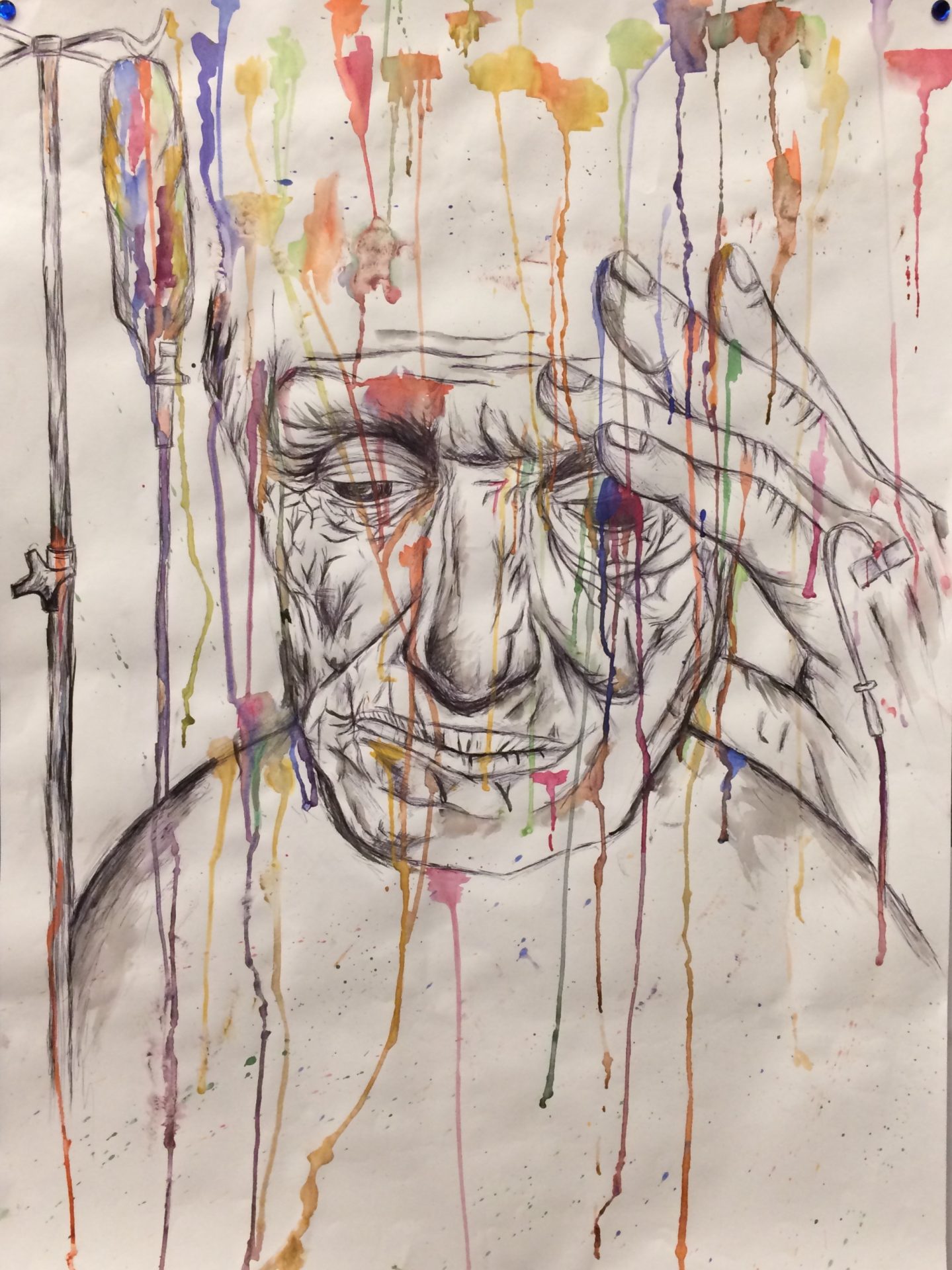The Wait
In Palliative Care the patient’s decisions concerning their life-choices are as important or sometimes more important than that of the doctor. Average life expectancy is rising and patients whose illnesses cannot be cured deserve respect, and quality care from all the healthcare professionals they encounter in their final years. The value of company itself is not to be underestimated.
Andrew William James, Titilope Jempeji, Nikita Jha, Lauren Emily Jinks, Davis John, Toby Jones, Aminata Kaloko, Atchchuthan Kanagasabai, Keya Karan, Helena Kilgour, Samuel James Knights.
Year One. Foundations of Medicine Conference, 2018.

I have chosen to review this art piece as I think that it is a thought-provoking work on an increasingly important aspect of medicine. The painting implies the weight of the decisions patients in palliative care have to think about: balancing what they want, what their families want and what medical staff advise. This piece reminds us that it is their desires are what are fundamentally important. I think that this piece also shows that some patients may also be very lonely towards the end of their life, especially if they have outlived their family and friends.
This is a very interesting piece of art. When first looking at it the painting, the first thing that springs into mind is what is the person in the painting thinking about? It could be about their illness, their family, their favourite/ worst memories, or maybe what they think they will miss when they are gone. The truth is that we will never know what they are thinking unless we ask. As the authors say, the value of company and having people to talk to is immense and can help people in their darkest times. It is also interesting how the patient has been pictured in black and white, with coloured paint drizzling past their body. To me, this has the effect of showing that even with all the things going on around us, life can still be a very dark place if we have no one to experience it with.
This artwork made me reflect on the complexities of the decision-making process for patients undergoing palliative care. Although giving patients choices about their care can empower them, the weight of these decisions can also overwhelm them and cause them to feel isolated. Feeling that they have to make the right choices in the eyes of their family members, friends and doctors as well as themselves can lead to feelings of anxiousness and fears of letting others down. These emotions are beautifully displayed in this piece of art. This emphasises the need for support systems and human company for patients in this position.
This particular piece jumped out at me considering not many people understand the mental toll being terminally ill has on people. Most of their last moments will be with healthcare professionals hence they must provide them with the utmost, holistic care. All of the medicines given are futile in changing the outcome therefore it may be hard for the patient to have any positive thoughts. This portrays the fact that support services need to be targeted toward patients in palliative care, to give them somewhat of a positive outlook on their last moments.
The colours in this painting spoke out to me as they seem to represent the multiple issues weighing on the patients mind whereas the patient is depicted in black and white which perhaps represents how down they feel and the impact of continuous treatment and the uncertainty that surrounds their treatment. This coupled with the sad expression on the subjects face gives the impression that it is a very difficult time. This is poignant as it suggests to us and every healthcare worker that the toll of palliative care on a patient is very hard and that both the physical and mental health care has to be taken care of equally.
This artwork is a very emotive piece that portrays the anxieties of patients during palliative care. It stood out to me as it made me reflect on the difficulties patients must face when terminally ill. The array of colours illustrate the many thoughts that a patient in palliative care will have constantly. Things like making decisions about themselves when for many this will be difficult while feeling a sense of hopelessness. As a future doctor, I know that it is my duty to treat these patients with respect and dignity and provide them with care that ensures they are supported both physically and mentally.
This is a powerful piece that highlights the colourful thoughts and life of the patient that contrast with the grim black and white exterior. The medical professionals that look after patients in palliative care wards often do not know the lives the patients lived before their illness. They don’t know the patient’s favourite colour, food or piece of music. And so when decisions are made for to keep them comfortable and aware, they are often made without any idea of what the patient truly wants. The colours of this piece may reflect the patients thoughts and preferences that seem to be unspoken and ignored in this case.